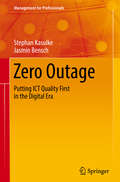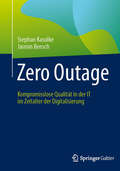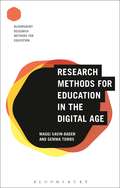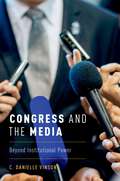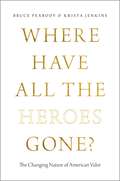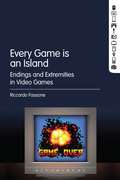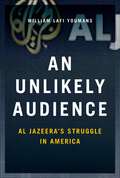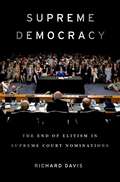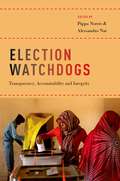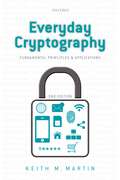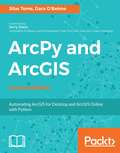- Table View
- List View
Zero Outage: Putting ICT Quality First in the Digital Era (Management for Professionals)
by Stephan Kasulke Jasmin Bensch Ferri AbolhassanThis reference book shows how the Zero Outage method leads to more stability in operations, more reliability in projects and, ultimately, to greater customer satisfaction. It explains why clear standards for platforms, processes and personnel are essential for ensuring high ICT quality from end to end and what to look out for during changes – the most common cause of IT outages. Readers also learn how to resolve errors as quickly as possible and permanently eliminate them, and why industry-wide collaboration will only be possible with a shared standard of quality. This book is a practical introduction to making your ICT world even more failsafe and efficient. The authors share key knowledge in quality management and offer an exclusive insight into their extensively tested and continually enhanced formula for success: the Zero Outage approach.
Zero Outage: Kompromisslose Qualität in der IT im Zeitalter der Digitalisierung
by Stephan Kasulke Jasmin Bensch Ferri AbolhassanDas Fachbuch zeigt, wie die Zero-Outage-Methode zu mehr Stabilität im Betrieb, mehr Zuverlässigkeit in Projekten und letztlich zu einer größeren Kundenzufriedenheit führt. Es verdeutlicht, weshalb klare Standards bei Plattformen, Prozessen und Personal unverzichtbar sind, um eine hohe ICT-Qualität von Ende zu Ende sicherzustellen und worauf es bei Changes – den häufigsten Ursachen für IT-Ausfälle – ankommt. Zudem erfahren die Leser, wie man Störungen schnellstmöglich behebt und dauerhaft abstellt und warum die Zusammenarbeit von ICT-Anbietern künftig nur mit einem gemeinsamen Qualitätsstandard gelingen kann. So dient dieses Buch als praxisnahe Anleitung, die eigene ICT-Welt noch ausfallsicherer und leistungsfähiger zu machen. Dazu teilen die Autoren ihre wichtigsten Erkenntnisse im Qualitätsmanagement und geben einen exklusiven Einblick in ihr – über viele Jahre erprobtes und kontinuierlich weiterentwickeltes – Erfolgsrezept: den Zero-Outage-Ansatz.
Research Methods for Education in the Digital Age (Bloomsbury Research Methods for Education)
by Maggi Savin-Baden Gemma TombsWhat is research in education? And what is it for in a digital age? Reflecting upon these questions, this engaging introduction provides critical discussion about the dilemmas of researching education in the digital age and ways forward for research in this complex area. Research Methods for Education in the Digital Age begins by outlining forms of education that are seen as digital, such as virtual, blended, immersive learning and examining the extent to which these are different or just adapted versions of earlier methods and approaches to education. Maggi Savin-Baden and Gemma Tombs explore current practices in research, identifying the successful adoption and adaption of theories and present practical guidance on new and emerging methodologies, methods, and analytical practices for undertaking educational research. New methodologies discussed include digital arts-based inquiry and digital visual methodologies, as well as adaptations of widely used methodologies such as ethnography, for the specific needs of researching digital teaching and learning. The book outlines the major challenges faced by today's digital researchers, exploring approaches to digital ethics, the relationship between qualitative and quantitative data in the digital age, digital data representations and portrayal and suggests helpful ways of dealing with the complexities and ethical challenges of undertaking research in and for digital spaces. Using case studies, research tips, a glossary and annotated further reading, the authors take a step by step approach from conceptualizing the research ideas, selecting the appropriate method to the dissemination of the findings. At a time when education is changing rapidly with digital and technological advances, Research Methods for Education in the Digital Age is essential reading for researchers wanting to undertake sound and rigorous research in the digital domain.
Congress and the Media: Beyond Institutional Power
by C. Danielle VinsonOver the last four decades, members of Congress have increasingly embraced media relations as a way to influence national policymaking and politics. In 1977, nearly half of congressional members had no press secretary. Today, media relations is a central component of most congressional offices, and more of that communications effort is directed toward national media, not just the local press. Arguing that members of Congress turn to the media to enhance their formal powers or to compensate for their lack of power, Congress and the Media explains why congressional members go public and when they are likely to succeed in getting coverage. Vinson uses content analysis of national newspaper and television coverage of congressional members over time and members' messages on social media as well as case studies to examine how members in different political circumstances use the media to try to influence policymaking and how this has changed over time. She finds that members' institutional position, the political context, increasing partisan polarization, and journalists' evolving notions of what is newsworthy all affect which congressional members are interested in and successful in gaining media coverage of their messages and what they hope to accomplish by going public. Ultimately, Congress and the Media suggests that going public can be a way for members of Congress to move beyond their institutional powers, but the strategy is not equally available to all members nor effective for all goals.
Where Have All the Heroes Gone?: The Changing Nature of American Valor
by Bruce Peabody Krista JenkinsFrom the men and women associated with the American Revolution and Civil War to the seminal figures in the struggles for civil and women's rights, Americans have been fascinated with icons of great achievement, or at least reputation. But who spins today's narratives about American heroism, and to what end? In Where Have All the Heroes Gone?, Bruce Peabody and Krista Jenkins draw on the concept of the American hero to show an important gap between the views of political and media elites and the attitudes of the mass public. The authors contend that important changes over the past half century, including the increasing scope of new media and people's deepening political distrust, have drawn both politicians and producers of media content to the hero meme. However, popular reaction to this turn to heroism has been largely skeptical. As a result, the conversations and judgments of ordinary Americans, government officials, and media elites are often deeply divergent. Investigating the story of American heroes over the past five decades provides a narrative that can teach us about such issues as political socialization, institutional trust, and political communication.
Every Game is an Island: Endings and Extremities in Video Games
by Riccardo FassoneDespite the pervasive rhetorics of immersion and embodiment found in industrial and social discourses, playing a video game is an exercise in non-linearity. The pervasiveness of trial and error mechanics, unforgiving game over screens, loading times, minute tweakings of options and settings, should lead us to consider video games as a medium that cannot eschew fragmentation. Every Game is an Island is an analysis and a critique of grey areas, dead ends and extremities found in digital games, an exploration of border zones where play and non-play coexist or compete. Riccardo Fassone describes the complexity of the experience of video game play and brings integral but often overlooked components of the gameplay experience to the fore, in an attempt to problematize a reading of video games as grandiosely immersive, all-encompassing narrative experiences. Through the analysis of closures and endings, limits and borders, and liminal states, this field-advancing study looks at the heart of a medium starting from its periphery.
The Ideas Industry: How Pessimists, Partisans, and Plutocrats are Transforming the Marketplace of Ideas
by Daniel W. DreznerThe public intellectual has a long and storied history. Previously, the public intellectual was always expected to opine on a broad array of topics, from foreign policy to economics. Yet in recent years a new kind of thinker has supplanted that archetype: the thought leader. Equipped with one big idea, thought leaders focus their energies on TED talks rather than highbrow periodicals. In contrast to public intellectuals, thought leaders gain fame as single-idea merchants. Their ideas are often laudable and highly ambitious, but they often work through institutions that are closed to the public and less open to criticism. In The Ideas Industry, Daniel W. Drezner explains how this shift happened, pointing to the roles of political polarization, heightened inequality, and eroding trust in authority. In contrast to their predecessors, today's intellectuals are more likely to enjoy the support of ideologically friendly private funders and be housed in ideologically-driven think tanks. Increasing inequality is also a key driver of this shift: more than ever before, contemporary plutocrats fund intellectuals and idea factories that generate arguments that align with their own. Finally, the erosion of trust in experts has lowered the barriers of entry in the marketplace of ideas. But, while there are certainly some downsides to the contemporary ideas industry, Drezner argues that it is very good at broadcasting ideas widely and reaching large audiences hungry for new thinking. Both fair-minded and trenchant, The Ideas Industry reshapes our understanding of contemporary public intellectual life in America and the West.
Digital Justice: Technology and the Internet of Disputes
by Ethan Katsh Orna Rabinovich-EinyImproving access to justice has been an ongoing process, and on-demand justice should be a natural part of our increasingly on-demand society. What can we do for example when Facebook blocks our account, we're harassed on Twitter, discover that our credit report contains errors, or receive a negative review on Airbnb? How do we effectively resolve these and other such issues? Digital Justice introduces the reader to new technological tools to resolve and prevent disputes bringing dispute resolution to cyberspace, where those who would never look to a court for assistance can find help for instance via a smartphone. The authors focus particular attention on five areas that have seen great innovation as well as large volumes of disputes: ecommerce, healthcare, social media, labor, and the courts. As conflicts escalate with the increase in innovation, the authors emphasize the need for new dispute resolution processes and new ways to avoid disputes, something that has been ignored by those seeking to improve access to justice in the past.
Implementing DevOps with Microsoft Azure
by Mitesh SoniAccelerate and Automate Build, Deploy, and Management of applications to achieve High Availability. About This Book • This guide highlights tools that offer development and deployment environments for application services • Secure and continuously monitor your web application in order to make it highly available • Use Visual Studio Team Services for Continuous Integration and Continuous Development to expedite your application life cycle management process • Use Microsoft Azure App Services (Azure Web Apps / Azure Websites), PaaS offering from Microsoft to deploy web application Who This Book Is For This book is for DevOps engineers, system administrators, and developers (.net) who want to implement DevOps for their organization. You do not need to have any knowledge of VSTS or Azure App Services (Azure Web Apps / Azure Websites). What You Will Learn • Explore the features of PaaS and aPaaS in DevOps • Use Visual Studio Team Services (VSTS) to manage versions of code and integrating VSTS with Eclipse IDE • Understand and configure Continuous Integration in VSTS • Review Unit Test Execution for Automated Testing • Create different environments that can be used to continuous deploy a web application • Configure Roll-based Access to enable secure access for Azure Web Apps • Create and configure the App Service Environment to enhance security • Understand the execution of the end-to-end automation process • Conduct Performance Testing using JMeter • Discover the different monitoring options available in Microsoft Azure Portal In Detail This book will teach you all about the Visual Studio Team Services and Microsoft Azure PaaS offerings that support Continuous Integration, Continuous Delivery, Continuous Deployment, and execution in the cloud with high availability, disaster recovery, and security. You will first be given a tour of all the concepts and tools that Microsoft Azure has to offer and how these can be used in situations to cultivate the DevOps culture. You'll be taught how to use and manage Visual Studio Team Services (VSTS) and about the structure of the sample application used throughout the book. You will become familiar with the nitty gritty of Continuous Integration and Continuous Development with VSTS and Microsoft Azure Apps. You will not only learn how to create App service environments, but also how to compare Azure Web Apps and App Service Environments to deploy web applications in a more secure environment. Once you have completed Continuous Integration and created the Platform for application deployment, you will learn more about the final stepping stone in achieving end-to-end automation using approval-based Continuous Delivery and Deployment. You will then learn about Continuous Monitoring, using the monitoring and notification options provided by Microsoft Azure and Visual Studio Team Services. Style and Approach This book is an easy-to-follow guide filled with examples and real-world applications for gaining an in-depth understanding of Microsoft Azure and Visual Studio. This book will help you leverage Microsoft Azure and Visual Studio using real-world examples.
The Citizen Marketer: Promoting Political Opinion in the Social Media Age (Oxford Studies in Digital Politics)
by Joel PenneyFrom hashtag activism to the flood of political memes on social media, the landscape of political communication is being transformed by the grassroots circulation of opinion on digital platforms and beyond. By exploring how everyday people assist in the promotion of political media messages to persuade their peers and shape the public mind, Joel Penney offers a new framework for understanding the phenomenon of viral political communication: the citizen marketer. Like the citizen consumer, the citizen marketer is guided by the logics of marketing practice, but, rather than being passive, actively circulates persuasive media to advance political interests. Such practices include using protest symbols in social media profile pictures, strategically tweeting links to news articles to raise awareness about select issues, sharing politically-charged internet memes and viral videos, and displaying mass-produced T-shirts, buttons, and bumper stickers that promote a favored electoral candidate or cause. Citizens view their participation in such activities not only in terms of how it may shape or influence outcomes, but as a statement of their own identity. As the book argues, these practices signal an important shift in how political participation is conceptualized and performed in advanced capitalist democratic societies, as they casually inject political ideas into the everyday spaces and places of popular culture. While marketing is considered a dirty word in certain critical circles -- particularly among segments of the left that have identified neoliberal market logics and consumer capitalist structures as a major focus of political struggle -- some of these very critics have determined that the most effective way to push back against the forces of neoliberal capitalism is to co-opt its own marketing and advertising techniques to spread counter-hegemonic ideas to the public. Accordingly, this book argues that the citizen marketer approach to political action is much broader than any one ideological constituency or bloc. Rather, it is a means of promoting a wide range of political ideas, including those that are broadly critical of elite uses of marketing in consumer capitalist societies. The book includes an extensive historical treatment of citizen-level political promotion in modern democratic societies, connecting contemporary digital practices to both the 19th century tradition of mass political spectacle as well as more informal, culturally-situated forms of political expression that emerge from postwar countercultures. By investigating the logics and motivations behind the citizen marketer approach, as well as how it has developed in response to key social, cultural, and technological changes, Penney charts the evolution of activism in an age of mediatized politics, promotional culture, and viral circulation.
Reclaiming Information and Communication Technologies for Development
by Tim UnwinThe development of new Information and Communication Technologies (ICTs) has transformed the world over the last two decades. These technologies are often seen as being inherently 'good', with the ability to make the world better, and in particular to reduce poverty. However, their darker side is frequently ignored in such accounts. ICTs undoubtedly have the potential to reduce poverty, for example by enhancing education, health delivery, rural development and entrepreneurship across Africa, Asia and Latin America. However, all too often, projects designed to do so fail to go to scale, and are unsustainable when donor funding ceases. Indeed, ICTs have actually dramatically increased inequality across the world. The central purpose of this book is to account for why this is so, and it does so primarily by laying bare the interests that have underlain the dramatic expansion of ICTs in recent years. Unless these are fully understood, it will not be possible to reclaim the use of these technologies to empower the world's poorest and most marginalised.
An Unlikely Audience: Al Jazeera's Struggle in America
by William YoumansIn 2006, the Al Jazeera Media Network sought to penetrate the United States media sphere, the world's most influential national market for English language news. These unyielding ambitions surprised those who knew the network as the Arab media service President Bush lambasted as "hateful propaganda" in his 2004 State of the Union address. The world watched skeptically yet curiously as Al Jazeera labored to establish a presence in the famously insular American market. The network's decade-long struggle included both fleeting successes, like the sudden surge of popular interest during the Arab spring, as well as momentous failures. The April 2016 closure of its $2 billion Al Jazeera America channel was just one of a series of setbacks. An Unlikely Audience investigates the inner workings of a complex news organization fighting to overcome deep obstacles, foster strategic alliances and build its identity in a country notoriously disinterested in international news. William Youmans argues counter-intuitively that making sense of Al Jazeera's tortured push into the United States as a national news market, actually requires a local lens. He reveals the network's appeal to American audiences by presenting its three independent US-facing subsidiaries in their primary locales of production: Al Jazeera English (AJE) in Washington, DC, Al Jazeera America (AJAM) in New York, and AJ+ in San Francisco. These cities are centers of vital industries-media-politics, commercial TV news and technology, respectively. As Youmans shows, the success of the outlets hinged on the locations in which they operated because Al Jazeera assimilated aspects of their core industries. An Unlikely Audience proves that place is critical to the formation and evolution of multi-national media organizations, despite the rise of communication technologies that many believe make location less relevant. Mining data from over 50 interviews since 2010, internal documents, and original surveys, the book offers a brisk and authoritative account of the world's most recognizable media-brand and its decade-long ingress into the US - crucial background for Al Jazeera's continued expansion in the United States.
Privacy: What Everyone Needs to Know® (What Everyone Needs To Know®)
by Leslie P. Francis John G. FrancisWe live more and more of our lives online; we rely on the internet as we work, correspond with friends and loved ones, and go through a multitude of mundane activities like paying bills, streaming videos, reading the news, and listening to music. Without thinking twice, we operate with the understanding that the data that traces these activities will not be abused now or in the future. There is an abstract idea of privacy that we invoke, and, concrete rules about our privacy that we can point to if we are pressed. Nonetheless, too often we are uneasily reminded that our privacy is not invulnerable-the data tracks we leave through our health information, the internet and social media, financial and credit information, personal relationships, and public lives make us continuously prey to identity theft, hacking, and even government surveillance. A great deal is at stake for individuals, groups, and societies if privacy is misunderstood, misdirected, or misused. Popular understanding of privacy doesn't match the heat the concept generates. With a host of cultural differences as to how privacy is understood globally and in different religions, and with ceaseless technological advancements, it is an increasingly complex topic. In this clear and accessible book, Leslie and John G. Francis guide us to an understanding of what privacy can mean and why it is so important. Drawing upon their extensive joint expertise in law, philosophy, political science, regulatory policy, and bioethics, they parse the consequences of the forfeiture, however great or small, of one's privacy.
Supreme Democracy: The End of Elitism in Supreme Court Nominations
by Richard DavisIn the nineteenth and early twentieth centuries, Supreme Court nominations were driven by presidents, senators, and some legal community elites. Many nominations were quick processes with little Senate deliberation, minimal publicity and almost no public involvement. Today, however, confirmation takes 81 days on average-Justice Antonin Scalia's former seat has already taken much longer to fill-and it is typically a media spectacle. How did the Supreme Court nomination process become so public and so nakedly political? What forces led to the current high-stakes status of the process? How could we implement reforms to improve the process? In Supreme Democracy: The End of Elitism in the Supreme Court Nominations, Richard Davis, an eminent scholar of American politics and the courts, traces the history of nominations from the early republic to the present. He examines the component parts of the nomination process one by one: the presidential nomination stage, the confirmation management process, the role of the Senate Judiciary Committee, and the increasing involvement over time of interest groups, the news media, and public opinion. The most dramatic development, however, has been the democratization of politics. Davis delves into the constitutional underpinnings of the nomination process and its traditional form before describing a more democratic process that has emerged in the past half century. He details the struggle over image-making between supporters and opponents intended to influence the news media and public opinion. Most importantly, he provides a thorough examination of whether or not increasing democracy always produces better governance, and a better Court. Not only an authoritative analysis of the Supreme Court nomination process from the founding era to the present, Supreme Democracy will be an essential guide to all of the protracted nomination battles yet to come.
Election Watchdogs: Transparency, Accountability and Integrity
Recent decades have seen growing concern regarding problems of electoral integrity. The most overt malpractices used by rulers include imprisoning dissidents, harassing adversaries, coercing voters, vote-rigging counts, and even blatant disregard for the popular vote. Elsewhere minor irregularities are common, exemplified by inaccurate voter registers, maladministration of polling facilities, lack of security in absentee ballots, pro-government media bias, ballot miscounts, and gerrymandering. Serious violations of human rights that undermine electoral credibility are widely condemned by domestic observers and the international community. Recent protests about integrity have mobilized in countries as diverse as Russia, Mexico, and Egypt. However, long-standing democracies are far from immune to these ills; past problems include the notorious hanging chads in Florida in 2000 and more recent accusations of voter fraud and voter suppression during the Obama-Romney contest. When problems come to light, however, is anyone held to account and are effective remedies implemented? In response to these developments, there have been growing attempts to analyze flaws in electoral integrity and transparency using systematic data from cross-national time-series, forensic analysis, field experiments, case studies, and new instruments monitoring mass and elite perceptions of malpractices. This volume collects essays from international experts who evaluate the robustness, conceptual validity, and reliability of the growing body of evidence. The essays compare alternative approaches and apply these methods to evaluate the quality of elections in several areas, including the United States, Sub-Saharan Africa, and Latin America. Election Watchdogs:Transparency, Accountability and Integrity presents new insights into the importance of diverse actors who promote electoral transparency, accountability, and ultimately the integrity of electoral governance.
Learning RxJava
by Thomas NieldReactive Programming with Java and ReactiveX About This Book • Explore the essential tools and operators RxJava provides, and know which situations to use them in • Delve into Observables and Subscribers, the core components of RxJava used for building scalable and performant reactive applications • Delve into the practical implementation of tools to effectively take on complex tasks such as concurrency and backpressure Who This Book Is For The primary audience for this book is developers with at least a fundamental mastery of Java. Some readers will likely be interested in RxJava to make programs more resilient, concurrent, and scalable. Others may be checking out reactive programming just to see what it is all about, and to judge whether it can solve any problems they may have. What You Will Learn • Learn the features of RxJava 2 that bring about many significant changes, including new reactive types such as Flowable, Single, Maybe, and Completable • Understand how reactive programming works and the mindset to "think reactively" • Demystify the Observable and how it quickly expresses data and events as sequences • Learn the various Rx operators that transform, filter, and combine data and event sequences • Leverage multicasting to push data to multiple destinations, and cache and replay them • Discover how concurrency and parallelization work in RxJava, and how it makes these traditionally complex tasks trivial to implement • Apply RxJava and Retrolambda to the Android domain to create responsive Android apps with better user experiences • Use RxJava with the Kotlin language to express RxJava more idiomatically with extension functions, data classes, and other Kotlin features In Detail RxJava is a library for composing asynchronous and event-based programs using Observable sequences for the JVM, allowing developers to build robust applications in less time. Learning RxJava addresses all the fundamentals of reactive programming to help readers write reactive code, as well as teach them an effective approach to designing and implementing reactive libraries and applications. Starting with a brief introduction to reactive programming concepts, there is an overview of Observables and Observers, the core components of RxJava, and how to combine different streams of data and events together. You will also learn simpler ways to achieve concurrency and remain highly performant, with no need for synchronization. Later on, we will leverage backpressure and other strategies to cope with rapidly-producing sources to prevent bottlenecks in your application. After covering custom operators, testing, and debugging, the book dives into hands-on examples using RxJava on Android as well as Kotlin. Style and approach This book will be different from other Rx books, taking an approach that comprehensively covers Rx concepts and practical applications.
The Python Apprentice
by Austin Bingham Robert SmallshireLearn the Python skills and culture you need to become a productive member of any Python project. About This Book • Taking a practical approach to studying Python • A clear appreciation of the sequence-oriented parts of Python • Emphasis on the way in which Python code is structured • Learn how to produce bug-free code by using testing tools Who This Book Is For The Python Apprentice is for anyone who wants to start building, creating and contributing towards a Python project. No previous knowledge of Python is required, although at least some familiarity with programming in another language is helpful. What You Will Learn • Learn the language of Python itself • Get a start on the Python standard library • Learn how to integrate 3rd party libraries • Develop libraries on your own • Become familiar with the basics of Python testing In Detail Experienced programmers want to know how to enhance their craft and we want to help them start as apprentices with Python. We know that before mastering Python you need to learn the culture and the tools to become a productive member of any Python project. Our goal with this book is to give you a practical and thorough introduction to Python programming, providing you with the insight and technical craftsmanship you need to be a productive member of any Python project. Python is a big language, and it's not our intention with this book to cover everything there is to know. We just want to make sure that you, as the developer, know the tools, basic idioms and of course the ins and outs of the language, the standard library and other modules to be able to jump into most projects. Style and approach We introduce topics gently and then revisit them on multiple occasions to add the depth required to support your progression as a Python developer. We've worked hard to structure the syllabus to avoid forward references. On only a few occasions do we require you to accept techniques on trust, before explaining them later; where we do, it's to deliberately establish good habits.
Everyday Cryptography: Fundamental Principles and Applications
by Keith MartinCryptography is a vital technology that underpins the security of information in computer networks. This book presents a comprehensive introduction to the role that cryptography plays in providing information security for everyday technologies such as the Internet, mobile phones, Wi-Fi networks, payment cards, Tor, and Bitcoin. This book is intended to be introductory, self-contained, and widely accessible. It is suitable as a first read on cryptography. Almost no prior knowledge of mathematics is required since the book deliberately avoids the details of the mathematics techniques underpinning cryptographic mechanisms. Instead our focus will be on what a normal user or practitioner of information security needs to know about cryptography in order to understand the design and use of everyday cryptographic applications. By focusing on the fundamental principles of modern cryptography rather than the technical details of current cryptographic technology, the main part this book is relatively timeless, and illustrates the application of these principles by considering a number of contemporary applications of cryptography. Following the revelations of former NSA contractor Edward Snowden, the book considers the wider societal impact of use of cryptography and strategies for addressing this. A reader of this book will not only be able to understand the everyday use of cryptography, but also be able to interpret future developments in this fascinating and crucially important area of technology.
The Oxford Handbook of Political Communication (Oxford Handbooks)
Since its development shaped by the turmoil of the World Wars and suspicion of new technologies such as film and radio, political communication has become a hybrid field largely devoted to connecting the dots among political rhetoric, politicians and leaders, voters' opinions, and media exposure to better understand how any one aspect can affect the others. In The Oxford Handbook of Political Communication Kate Kenski and Kathleen Hall Jamieson bring together leading scholars, including founders of the field of political communication Elihu Katz, Jay Blumler, Doris Graber, Max McCombs, and Thomas Paterson,to review the major findings about subjects ranging from the effects of political advertising and debates and understandings and misunderstandings of agenda setting, framing, and cultivation to the changing contours of social media use in politics and the functions of the press in a democratic system. The essays in this volume reveal that political communication is a hybrid field with complex ancestry, permeable boundaries, and interests that overlap with those of related fields such as political sociology, public opinion, rhetoric, neuroscience, and the new hybrid on the quad, media psychology. This comprehensive review of the political communication literature is an indispensible reference for scholars and students interested in the study of how, why, when, and with what effect humans make sense of symbolic exchanges about sharing and shared power. The sixty-two chapters in The Oxford Handbook of Political Communication contain an overview of past scholarship while providing critical reflection of its relevance in a changing media landscape and offering agendas for future research and innovation.
Learning Salesforce Einstein
by Mohith ShrivastavaIncorporate the power of Einstein in your Salesforce application About This Book • Make better predictions of your business processes using prediction and predictive modeling • Build your own custom models by leveraging PredictionIO on the Heroku platform • Integrate Einstein into various cloud services to predict sales, marketing leads, insights into news feeds, and more Who This Book Is For This book is for developers, data scientists, and Salesforce-experienced consultants who want to explore Salesforce Einstein and its current offerings. It assumes some prior experience with the Salesforce platform. What You Will Learn • Get introduced to AI and its role in CRM and cloud applications • Understand how Einstein works for the sales, service, marketing, community, and commerce clouds • Gain a deep understanding of how to use Einstein for the analytics cloud • Build predictive apps on Heroku using PredictionIO, and work with Einstein Predictive Vision Services • Incorporate Einstein in the IoT cloud • Test the accuracy of Einstein through Salesforce reporting and Wave analytics In Detail Dreamforce 16 brought forth the latest addition to the Salesforce platform: an AI tool named Einstein. Einstein promises to provide users of all Salesforce applications with a powerful platform to help them gain deep insights into the data they work on. This book will introduce you to Einstein and help you integrate it into your respective business applications based on the Salesforce platform. We start off with an introduction to AI, then move on to look at how AI can make your CRM and apps smarter. Next, we discuss various out-of-the-box components added to sales, service, marketing, and community clouds from salesforce to add Artificial Intelligence capabilities. Further on, we teach you how to use Heroku, PredictionIO, and the force.com platform, along with Einstein, to build smarter apps. The core chapters focus on developer content and introduce PredictionIO and Salesforce Einstein Vision Services. We explore Einstein Predictive Vision Services, along with analytics cloud, the Einstein Data Discovery product, and IOT core concepts. Throughout the book, we also focus on how Einstein can be integrated into CRM and various clouds such as sales, services, marketing, and communities. By the end of the book, you will be able to embrace and leverage the power of Einstein, incorporating its functions to gain more knowledge. Salesforce developers will be introduced to the world of AI, while data scientists will gain insights into Salesforce's various cloud offerings and how they can use Einstein's capabilities and enhance applications. Style and approach This book takes a straightforward approach to explain Salesforce Einstein and all of its potential applications. Filled with examples, the book presents the facts along with seasoned advice and real-world use cases to ensure you have all the resources you need to incorporate the power of Einstein in your work.
ArcPy and ArcGIS - Second Edition
by Silas Toms Dara O'BeirneUse Python modules such as ArcPy, ArcREST and the ArcGIS API for Python to automate the analysis and mapping of geospatial data. About This Book • Perform GIS analysis faster by automating tasks. • Access the spatial data contained within shapefiles and geodatabases and transform between spatial reference systems. • Automate the mapping of geospatial analyses and production of map books. Who This Book Is For If you are a GIS student or professional who needs an understanding of how to use ArcPy to reduce repetitive tasks and perform analysis faster, this book is for you. It is also a valuable book for Python programmers who want to understand how to automate geospatial analyses and implement ArcGIS Online data management. What You Will Learn • Understand how to integrate Python into ArcGIS and make GIS analysis faster and easier. • Create Python script using ArcGIS ModelBuilder. • Learn to use ArcGIS online feature services and the basics of the ArcGIS REST API • Understand the unique Python environment that is new with ArcGIS Pro • Learn about the new ArcGIS Python API and how to use Anaconda and Jupyter with it • Learn to control ArcGIS Enterprise using ArcPy In Detail ArcGIS allows for complex analyses of geographic information. The ArcPy module is used to script these ArcGIS analyses, providing a productive way to perform geo-analyses and automate map production. The second edition of the book focuses on new Python tools, such as the ArcGIS API for Python. Using Python, this book will guide you from basic Python scripting to advanced ArcPy script tools. This book starts off with setting up your Python environment for ArcGIS automation. Then you will learn how to output maps using ArcPy in MXD and update feature class in a geodatabase using arcpy and ArcGIS Online. Next, you will be introduced to ArcREST library followed by examples on querying, updating and manipulating ArcGIS Online feature services. Further, you will be enabling your scripts in the browser and directly interacting with ArcGIS Online using Jupyter notebook. Finally, you can learn ways to use of ArcPy to control ArcGIS Enterprise and explore topics on deployments, data quality assurances, data updates, version control, and editing safeguards. By the end of the book, you will be equipped with the knowledge required to create automated analysis with administration reducing the time-consuming nature of GIS. Style and approach The book takes a pragmatic approach, showing ways to automate repetitive tasks and utilizing features of ArcPy with ArcGIS Pro and ArcGIS online.
Learning Spring 5.0
by Tejaswini Mandar JogBuild, test, and secure robust enterprise-grade applications using the Spring Framework About This Book • Build an enterprise application throughout the book that communicates with a microservice • Define and inject dependencies into your objects using the IoC container • Make use of Spring's reactive features including tools and implement a reactive Spring MVC application Who This Book Is For This book is for Java developers who want to make use of the Spring framework to simplify their programming needs. What You Will Learn • Get to know the basics of Spring development and gain fundamental knowledge about why and where to use Spring Framework • Explore the power of Beans using Dependency Injection, wiring, and Spring Expression Language • Implement and integrate a persistent layer in your application and also integrate an ORM such as Hibernate • Understand how to manage cross-cutting with logging mechanism, transaction management, and more using Aspect-oriented programming • Explore Spring MVC and know how to handle requesting data and presenting the response back to the user • Get to grips with the integration of RESTful APIs and Messaging with WebSocket and STOMP • Master Reactive Programming using Spring MVC to handle non-blocking streams In Detail Spring is the most widely used framework for Java programming and with its latest update to 5.0, the framework is undergoing massive changes. Built to work with both Java 8 and Java 9, Spring 5.0 promises to simplify the way developers write code, while still being able to create robust, enterprise applications. If you want to learn how to get around the Spring framework and use it to build your own amazing applications, then this book is for you. Beginning with an introduction to Spring and setting up the environment, the book will teach you in detail about the Bean life cycle and help you discover the power of wiring for dependency injection. Gradually, you will learn the core elements of Aspect-Oriented Programming and how to work with Spring MVC and then understand how to link to the database and persist data configuring ORM, using Hibernate. You will then learn how to secure and test your applications using the Spring-test and Spring-Security modules. At the end, you will enhance your development skills by getting to grips with the integration of RESTful APIs, building microservices, and doing reactive programming using Spring, as well as messaging with WebSocket and STOMP. Style and approach Filled with examples, this tutorial-based book will help you gain all the knowledge you need to start producing enterprise-grade applications with Spring.
Comprehensive Ruby Programming
by Jordan HudgensThis book will provide you with all of the tools you need to be a professional Ruby developer. Starting with the core principles, such as syntax and best practices, and up to advanced topics like metaprogramming and big data analysis. About This Book • Provides the core skills required to become a Ruby programmer • Covers how to use the most popular Ruby Gem libraries • Includes details on regular expressions Who This Book Is For This is a complete course written from the ground up for beginners wanting to gain a solid understanding of the Ruby language. It starts at the beginning with how to install Ruby and work with it on multiple machines, so simply have a computer that's connected to the Internet and you'll be ready. What You Will Learn • Learn how to use Ruby code effectively, picking the right tool for the job and not duplicating built-in functionality • Gain best software development practices, and how to identify and fix common errors • Absorb core programming skills, such as variables, strings, loops, conditionals, and much more • Explore object-oriented programming and learn to create modular, reusable code that you can use across projects • Build 10 practical Ruby programs as you work through the book on topics such as big data analysis and solving Euler equations In Detail Ruby is a powerful, general-purpose programming language that can be applied to any task. Whether you are an experienced developer who wants to learn a new language or you are new to programming, this book is your comprehensive Ruby coding guide. Starting with the foundational principles, such as syntax, and scaling up to advanced topics such as big data analysis, this book will give you all of the tools you need to be a professional Ruby developer. A few of the key topics are: object-oriented programming, built-in Ruby methods, core programming skills, and an introduction to the Ruby on Rails and Sinatra web frameworks. You will also build 10 practical Ruby programs. Created by an experienced Ruby developer, this book has been written to ensure it focuses on the skills you will need to be a professional Ruby developer. After you have read this book, you will be ready to start building real-world Ruby projects. Style and approach This is a comprehensive course for learning the Ruby programming language that works methodically through everything that you need to know. It begins with the basics of the language and then works through some complete projects to apply your skills and ensure that you have fully absorbed them and can use them in the real world.
Frank Kane's Taming Big Data with Apache Spark and Python
by Frank KaneFrank Kane's hands-on Spark training course, based on his bestselling Taming Big Data with Apache Spark and Python video, now available in a book. Understand and analyze large data sets using Spark on a single system or on a cluster. About This Book • Understand how Spark can be distributed across computing clusters • Develop and run Spark jobs efficiently using Python • A hands-on tutorial by Frank Kane with over 15 real-world examples teaching you Big Data processing with Spark Who This Book Is For If you are a data scientist or data analyst who wants to learn Big Data processing using Apache Spark and Python, this book is for you. If you have some programming experience in Python, and want to learn how to process large amounts of data using Apache Spark, Frank Kane's Taming Big Data with Apache Spark and Python will also help you. What You Will Learn • Find out how you can identify Big Data problems as Spark problems • Install and run Apache Spark on your computer or on a cluster • Analyze large data sets across many CPUs using Spark's Resilient Distributed Datasets • Implement machine learning on Spark using the MLlib library • Process continuous streams of data in real time using the Spark streaming module • Perform complex network analysis using Spark's GraphX library • Use Amazon's Elastic MapReduce service to run your Spark jobs on a cluster In Detail Frank Kane's Taming Big Data with Apache Spark and Python is your companion to learning Apache Spark in a hands-on manner. Frank will start you off by teaching you how to set up Spark on a single system or on a cluster, and you'll soon move on to analyzing large data sets using Spark RDD, and developing and running effective Spark jobs quickly using Python. Apache Spark has emerged as the next big thing in the Big Data domain – quickly rising from an ascending technology to an established superstar in just a matter of years. Spark allows you to quickly extract actionable insights from large amounts of data, on a real-time basis, making it an essential tool in many modern businesses. Frank has packed this book with over 15 interactive, fun-filled examples relevant to the real world, and he will empower you to understand the Spark ecosystem and implement production-grade real-time Spark projects with ease. Style and approach Frank Kane's Taming Big Data with Apache Spark and Python is a hands-on tutorial with over 15 real-world examples carefully explained by Frank in a step-by-step manner. The examples vary in complexity, and you can move through them at your own pace.
Game Audio Development with Unity 5.X
by Micheal LanhamCreate ҁAA' quality game audio with new features and tools built for Unity About This Book • Explore the basics of audio development in Unity to create spatial sound, mixing, effects, composition, adaptive audio and more. • Leverage the Audio Mixer of Unity 5.x to create blockbuster sound and music for your game. • Learn about developing professional audio for games with FMOD Studio and composing original music with Reaper. • Build amazing audio synchronized graphic visualizations with Unity. • Understand how real-time character lip syncing can be implemented. Who This Book Is For The ideal target audience for this book will be game developers, both Indie as well as semi pro. No prior knowledge of Unity and audio development is assumed, What You Will Learn • Develop game audio and other audio effects with Unity • Getting familiar with the new Audio Mixer introduced in Unity 5 • Implement dynamic and adaptive audio using various tools and strategies • Explore interesting ways to incorporate audio into a game with sound visualization • Use 3rd party professional audio development tools like FMOD • Compose original music and record vocals • Understand and troubleshoot audio performance issues In Detail Game Audio is one of the key components in making a game successful and it is quite popular in the gaming industry. So if you are a game developer with an eye on capturing the gamer market then this book is the right solution for you. In this book, we will take you through a step by step journey which will teach you to implement original and engaging soundtracks and SFX with Unity 5.x. You will be firstly introduced to the basics of game audio and sound development in Unity. After going through the core topics of audio development: audio sources, spatial sound, mixing, effects, and more; you will then have the option of delving deeper into more advanced topics like dynamic and adaptive audio. You will also learn to develop dynamic and adaptive audio using the Unity Audio Mixer. Further, you will learn how professional third party tools like FMOD are used for audio development in Unity. You will then go through the creation of sound visualization techniques and creating your own original music using the simple yet powerful audio workstation Reaper. Lastly, you will go through tips, techniques and strategies to help you optimize game audio performance or troubleshoot issues. At the end of the book, you'll have gained the skills to implement professional sound and music. Along with a good base knowledge audio and music principles you can apply across a range of other game development tools. Style and approach This book will have a step by step practical approach where downloadable free games will be given with the book and readers will be free to work with them.
